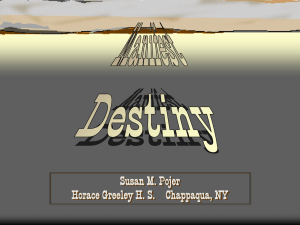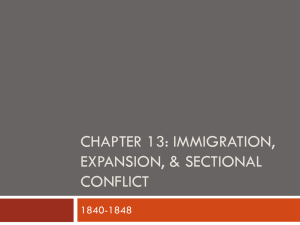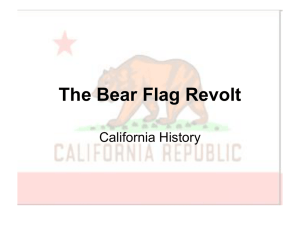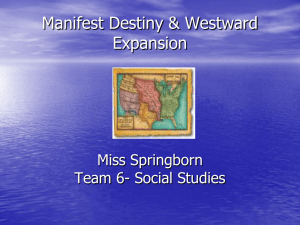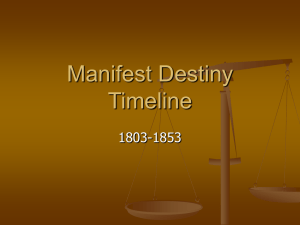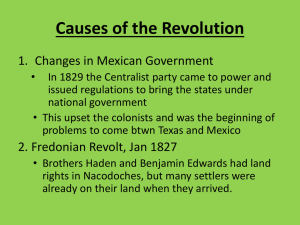THE FRUITS OF MANIFEST DESTINY
advertisement
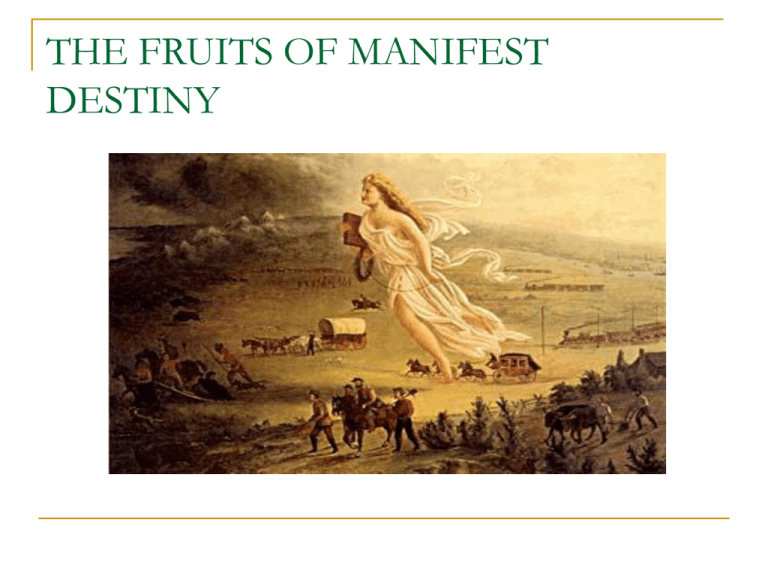
THE FRUITS OF MANIFEST
DESTINY
CONTINENTAL EXPANSION
1840s: Slavery moved
to the center stage of
American politics.
It did so not in the
moral language or with
the immediatist
program of
abolitionism, but as a
result of the nation’s
territorial expansion.
By 1840: With the
completion of Indian
removal, virtually all the
land east of the
Mississippi was in white
hands.
The depression that
began in 1837 sparked
a large migration of
settlers further west.
CONTINENTAL EXPANSION
1800-1840: Some 5,000
emigrants made the difficult
2,000 mile journey by
wagon train to Oregon from
jumping off places on the
banks of the Missouri River.
1860: Nearly 300,000 men,
women, and children had
braved disease, starvation,
the Rocky Mts., and
occasional Indian attacks to
travel overland to Oregon
and California.
CONTINENTAL EXPANSION
1840s: The USA and GB administered
Oregon, and Utah was part of Mexico.
This did not stop Americans from settling in
either region.
National boundaries meant little to those who
moved west.
The era witnessed an intensification of the
old belief that God intended the American
nation to reach all the way to the Pacific
Ocean = Manifest Destiny.
THE MORMONS’ PLIGHT
Another migration
brought thousands of
members of the Church
of Jesus Christ of
Latter-day Saints, or
Mormons, to modernday Utah.
THE MORMONS’ PLIGHT
The Mormons were
founded in the 1820s
by Joseph Smith, a
young farmer in upstate
NY.
He claimed to have
been led by an angel to
a set of golden plates
covered with strange
writing.
THE MORMONS’ PLIGHT
He translated the book
as The Book of
Mormon.
He claimed that his
church descended from
the lost tribes of Israel.
THE MORMONS’ PLIGHT
The absolute authority Smith exercised over
his followers, as well as the refusal of the
Mormons to separate church and state,
alarmed many neighbors.
Even more outrageous to the general
community was the Mormon practice of
polygamy – a repudiation of traditional
Christian teaching and 19th century morality.
THE MORMONS’ PLIGHT
Mobs drove Smith and his followers out of NY, OH
and MS.
1839: They settled in Illinois where they hoped to
await the Second Coming of Jesus Christ.
1844: Smith was arrested on the charge of inciting a
riot that destroyed an anti-Mormon newspaper.
While in jail, he was murdered by a group of
intruders.
THE MORMONS’ PLIGHT
Smith’s successor was
Brigham Young.
He led over 10,000
followers across the
Great Plains and Rocky
Mts., to the shores of
the Great Salt Lake in
Utah, seeking a refuge
where they could
practice their faith
undistrubed.
THE MEXICAN FRONTIER
THE MEXICAN FRONTIER
The settlement of
Oregon did not directly
raise the issue of
slavery.
But the nation’s
acquisition of Mexico
did.
THE MEXICAN FRONTIER
1821: When Mexico
achieved its independence
from Spain, it was nearly as
large as the US and its
population of 6.5 million
was about 2/3 that of its
northern neighbor
Mexico’s northern provinces
– CA, NM, and TX –
however were isolated and
sparsely settled outposts
surrounded by Indian
country.
NM’s population at the time of
Mexican independence
consisted of around 30,000
persons of Spanish origin,
10,000 Pueblo Indians and an
“indeterminate number” of
“wild’ Indians.
1821: With the opening of the
Santa Fe Trail, NM’s
commerce with the US
eclipsed trade with the rest of
Mexico.
THE SANTA FE TRAIL
THE MEXICAN FRONTIER
1821: CA’s non-Indian
population of 3.200 was
vastly outnumbered by
about 20,000 Indians
living and working on
land owned by religious
missions and by
150,000 members of
unsubded tribes in the
interior.
THE MEXICAN FRONTIER
1834: The Mexican govt., dissolved the great
mission holdings and emancipated Indians working
for the Friars.
Most of the land ended up in the hands of a new
class of Mexican cattle ranchers, the Californios.
They referred to themselves as “people capable of
reason” as opposed to indios, whom they called
“people without reason.”
The area also attracted a small number of American
newcomers.
THE TEXAS REVOLT
THE TEXAS REVOLT
The first of Mexico to be
settled by significant
numbers of Americans
was TX, whose nonIndian population of
Spanish origins
(Tejanos) numbered
about 2,000 when
Mexico became
independent.
THE TEXAS REVOLT
In order to develop the
region, the Mexican
govt., accepted an offer
from Moses Austin, a
CT born farmer, to
colonize it with
Americans.
THE TEXAS REVOLT
1820: Austin received a
large land grant.
When he died his son
Stephen continued the
plan, reselling land in
smaller plots to
American settlers at .12
per acre.
THE TEXAS REVOLT
1830: The population of Americans had
reached around 7,000, considerably
exceeding the number of Tejanos.
Alarmed that its grip on the area was
weakening, the Mexican govt., annulled
existing land contracts and barred future
emigration from the USA.
Led by Stephen Austin, American settlers
demanded greater autonomy within Mexico.
THE TEXAS REVOLT
The issue of slavery
further exacerbated
matters.
Mexico had abolised
slavery, but local
authorities allowed
American settlers to
bring their slaves with
them.
THE TEXAS REVOLT
1835: When Mexico’s ruler
General Antonio Lopez de
Santa Anna sent an army to
impose central authority, the
Americans believed he was
coming to free the slaves.
His appearance sparked a
chaotic revolt in TX.
The rebels formed a
provisional govt., and called
for Texan independence.
THE BATTLE OF THE ALAMO
THE BATTLE OF THE ALAMO
March 13, 1836: Santa Anna’s army stormed
the Alamo, a mission compound in San
Antonio, killing its 187 American and Tejano
defenders.
“Remember the Alamo” became the Texans
rallying cry.
CROCKETT, BOWIE AND TRAVERS
THE ALAMO
STORMING OF THE ALAMO
THE BATTLE OF SAN JACINTO
THE BATTLE OF SAN JACINTO
April 1836: At the
Battle of San Jacinto,
Sam Houston, a former
gov. of TN, routed
Santa Anna’s army and
forced him to recognize
Texan independence.
Houston was elected
the first president of the
Republic of Texas.
THE TEXAS REVOLT
1837: The TX
Congress called for
union with the USA.
But fearing the political
disputes certain to
result from an attempt
to add another slave
state, Presidents
Jackson and Van Buren
shelved the question.
THE TEXAS REVOLT
Settlers from the USA poured into the region.
Many were slaveowners taking up fertile
cotton land.
1845: The population of TX reached nearly
150,000.
JAMES K. POLK AND EXPANSION
THE ELECTION OF 1844
THE ELECTION OF 1844
Texas annexation
remained on the
political backburner
until President John
Tyler revived it in hopes
of rescuing his failed
administration and
securing southern
support for renomination in 1844.
THE ELECTION OF 1844
April 1844: A letter by John
C. Calhoun, Tyler’s Sec. of
State, was leaked to the
press.
It linked the idea of
absorbing TX directly to the
goal of strengthening
slavery in the USA.
Some Southern leaders
hoped that TX could be
divided into several states,
thus enhancing the South’s
power in Congress.
THE ELECTION OF 1844
Later that month, Clay and
Martin Van Buren, the
prospective Whig and
Democratic candidates for
president met at Clay’s KY
plantation.
They agreed to issue letters
rejecting immediate
annexation of TX on the
grounds that it might
provoke war with Mexico.
THE ELECTION OF 1844
Clay and Van Buren
were reacting to the
issue of slavery in the
traditional manner – by
trying to keep it out of
national politics.
Clay went on to receive
the Whig nomination.
Van Buren failed in his
bid to gain the
Democratic nomination.
THE ELECTION OF 1844
The Democrats
nominated little-known
James K. Polk, a
former gov., of TN.
His main assets were
his support for
annexation and his
close association with
Andrew Jackson, still
the party’s most
popular figure.
THE ELECTION OF 1844
Polk was a slaveholder.
He owned substantial cotton plantations in
TN and MS, where conditions were so brutal
that only half of the slave children lived to the
age of 15, and adults frequently ran away.
THE ELECTION OF 1844
The Democratic
platform called for
annexation of TX and
reoccupation of
Oregon.
“Fifty-four forty of fight”
–American control of
Oregon all the way to
its northern boundary
became a popular
slogan.
THE ELECTION OF 1844
Polk was the first “dark-horse” candidate for
president.
Polk defeated Clay in an extremely close
election.
Polk’s margin in the popular vote was less
than 2%
THE ELECTION OF 1844
Had not James G. Birney,
running as the Liberty Party
candidate, received 16,000
votes in NY, mostly from
anti-slavery Whigs, Clay
would have been elected
president.
March 1845: Only days
before Polk’s inauguration,
Congress declared TX part
of the USA.
POLK AS PRESIDENT
Polk may have been virtually unknown, but
he assumed the presidency with a clearly
defined set of goals:
To reduce the tariff
Reestablish the independent treasury
Settle the dispute over the ownership of
Oregon
Bring CA into the Union.
POLK AS PRESIDENT
Congress soon enacted the first two goals,
and the third was accomplished in an
agreement with GB dividing OR at the 49th
parallel.
Many Northerners were bitterly disappointed
by this compromise, considering it a betrayal
of Polk’s campaign promise not to give up
any part of Oregon without a fight.
POLK AS PRESIDENT
Acquiring CA proved
more difficult.
Polk dispatched an
emissary to Mexico
offering to purchase the
region, but the Mexican
govt., refused to
negotiations.
POLK AS PRESIDENT
Spring 1846: Polk was
planning for military action.
April 1846: American
soldiers under Zachary
Taylor moved into the
region between the Nueces
River and the Rio Grande,
land claimed by both
countries on the disputed
border between TX and
Mexico.
THE MEXICAN WAR
This action made
conflict with Mexican
forces inevitable.
When fighting broke
out, Polk claimed that
the Mexicans had “shed
blood upon American
soil” and called for a
declaration of war.
THE MEXICAN WAR
Some in Congress were not
convinced by Polk’s claims
of American blood shed.
Abraham Lincoln introduced
a resolution demanding the
exact spot that blood was
shed.
This resolution is known as
the “spot resolution.”
THE MEXICAN WAR
The Mexican War was
the first American
conflict to be fought
primarily on foreign soil
and the first in which
American forces
occupied a foreign
capital.
Inspired by the fervor of
Manifest Destiny, a
majority of Americans
supported the war.
THE MEXICAN WAR
However a significant
minority in the North
dissented, fearing that
far from expanding the
“great empire of liberty,”
the Polk
Administration’s real
aim was to acquire land
for the expansion of
slavery.
THE MEXICAN WAR
Ulysses S. Grant, who
served with distinction in the
war, later called the war
“one of the most unjust ever
waged by a stronger nation
against a weaker nation,”
and indication that the USA
was beginning to act like
“European monarchies,” not
a democratic republic.
THE MEXICAN WAR
Henry David Thoreau, was
jailed in MA for refusing to
pay taxes as a protest over
the war.
Defending his actions, he
wrote an important essay
“On Civil Disobedience.”
“Under a government which
imprisons unjustly, the true
place of a just man is also a
prison.”
THE MEXICAN WAR
June 1846: A band of
American
insurrectionists
proclaimed CA freed
from Mexican control
and named Capt. John
C. Fremont its ruler.
THE MEXICAN WAR
July 1846: The US
Navy sailed into
Monterey and San
Francisco Harbors,
raised the American
flag and put an end to
the “bear flag republic.
THE MEXICAN WAR
American troops under
Gen. Stephen W. Kearney
occupied Santa Fe and then
set out for So. CA, where
they put down a Mexican
uprising.
Feb. 1847: Gen. Zachary
Taylor defeated Santa
Anna’s army at the Battle of
Buena Vista.
THE MEXICAN WAR
When the Mexican
govt. still refused to
negotiate, Pres. Polk
ordered American
forces under Gen.
Winfield Scott to march
toward Mexico City.
Sept. 1847: Scott’s
forces routed Mexican
defenders and
occupied the country’s
capital.
THE MEXICAN WAR
Feb.1848: The Treaty
of Guadalupe Hidalgo
was signed:
Mexico confirmed the
annexation of TX.
Ceded CA, present day
NM, AZ, NV, and UT to
the USA.
The USA paid Mexico
$15 million.
THE MEXICAN WAR
The Mexican Cession,
as the land acquired
from Mexico was
called, established the
present day boundaries
of the USA, except for
the Gadsden Purchase,
a parcel of land brought
from Mexico in 1853,
and Alaska acquired
from Russia in 1867.
THE MEXICAN WAR
RACE AND MANIFEST DESTINY
RACE AND MANIFEST DESTINY
With the end of the Mexican
War, the USA absorbed half
a million square miles of
Mexico’s territory, one-third
of that nation’s total area.
An estimated 75,000 to
100,000 Spanish-speaking
Mexicans and over 150,000
Indians inhabited the
Mexican Cession.
RACE AND MANIFEST DESTINY
The Treaty of
Guadalupe Hidalgo
guaranteed to “male
citizens” of the area
“the free enjoyment of
their liberty and
property” and “all the
rights” of Americans – a
provision designed to
protect the property of
large Mexican
landowners in CA.
RACE AND MANIFEST DESTINY
As to Indians, whose
homelands and hunting
grounds suddenly
became part of the
USA, the treaty referred
to them only as “savage
tribes” whom the USA
must prevent from
launching incursions
into Mexico across of
the new border {The
Rio Grande River}.
RACE AND MANIFEST DESTINY
The spirit of Manifest
Destiny gave a new
harshness to ideas about
racial superiority.
1840s: Territorial expansion
came to be seen as proof of
the innate superiority of the
“Anglo-Saxon” race – a
mythical construct defined
largely by its opposites:
blacks, Indians, Hispanics,
and Catholics.
RACE AND MANIFEST DESTINY
“Race,” declared John
O’Sullivan’s Democratic
Review, was the “key”
to the “history of
nations,” and the rise
and fall of empires.
RACE AND MANIFEST DESTINY
“Race” in the mid-19th century was a
shapeless notion involving color, culture,
national origin, class and religion.
Newspapers, magazines, and scholarly
works popularized the link between American
freedom and the supposedly innate libertyloving qualities of Anglo-Saxon Protestants.
RACE AND MANIFEST DESTINY
Manifest Destiny represented a triumph of
civilization, progress, and liberty over the
tyranny of the Catholic Church and the
inferiority of “mongrel races.”
Calls by some expansionists for the USA to
annex all of Mexico failed in part because of
fear that the nation could not assimilate its
large non-white Catholic population,
supposedly unfit for citizenship in a republic.
REDEFINING RACE
REDEFINING RACE
The imposition of the
American system of race
relations proved detrimental
to many inhabitants of the
newly acquired territories.
TX had already
demonstrated as much.
Mexico had already
abolished slavery and
declared persons of
Spanish, Indian and African
origin equal before the law.
REDEFINING RACE
The TX constitution,
adopted after
independence, included
protections for slavery and
denied civil rights to Indians
and persons of African
origins.
Only whites were permitted
to purchase land, and the
entrance of free blacks into
the state was prohibited
altogether.
REDEFINING RACE
The race issue was not
settled until the Civil
War – or was it?

